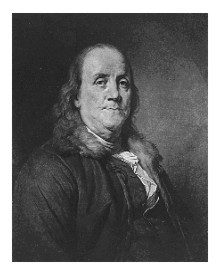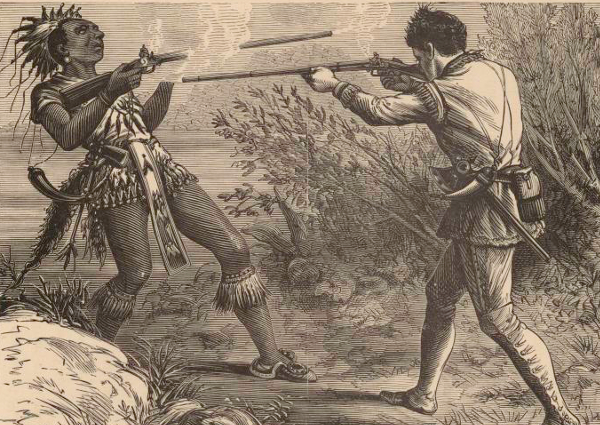Sponsor this page. Your banner or text ad can fill the space above.
Click here to Sponsor the page and how to reserve your ad.
-
Timeline
1729 Detail
July 25, 1729 - Lord proprietors sells out their interests in North Carolina to British Crown, establishing North Carolina as a Crown Colony.

The colony of the Carolinas had begun over sixty years prior when King Charles benefacted his friends, eight, as Lord Proprieters of the lands from the Virginia border to Florida and all the way west to the Pacific Ocean. They and their heirs had become rich men off the settlements that now dotted the area.
It had not been an easy journey to establish those communities, start and administer the governments that would arise, and fight off their enemies, whether that be in Queen Anne's War with the Spanish, or the later Tuscarora War between the colonists and tribes in North Carolina. On December 7, 1710, a partition was completed, making the Carolina colony two colonies; North Carolina and South Carolina. It would be run by the same eight proprieters, but be separate. By 1719, there was distrust of the proprieters in South Carolina, causing King George I to appoint a governor to South Carolina while the proprieters appointed the governor of North Carolina.
For South Carolina it had been slow growth with government hindrance, greed, lack of oversight, and personal rivalries. Add in the fact that the proprietors or their heirs rarely visited their holdings in the New World, leading to another round of abuse of power and graft. So in 1719, a bloodless Revolution of 1719 occurred when the citizens got tired of it, and installed their own government. It did not affect North Carolina, as it had its own separate government.
For the next ten years, the English government attempted to buy out the lord proprieters and their heirs, as well as establish a defined boundary between the Colony of Virginia and that of the Carolinas. That was accomplished in 1728. As far as the negotiations for becoming a Royal Colony, seven of the lord proprieters would eventually agree, and both North Carolina and South Carolina became Royal Colonies in 1729. The only proprieter who refused to sell was Lord Cartaret's family; they retained a one-eighth portion of the royal colony, the Granville District, until 1776.
The Cartaret Family and the Granville District
Vice Admiral Sir George Carteret, one of the eight original proprietors, had always been more involved in the affairs of the Colony of New Jersey than that of Carolina. However, the lands given to him in North Carolina were extensive. The Granville District ran south of the border with Virginia for sixty miles, between the north latitudes 35 degrees 34' and 36 degrees 30'. All told, it represented half of the acreage in the colony of North Carolina. George Cartaret's grandson, Lord John Cartaret, had no interest in selling, and held onto his landholdings in exchange for no participation in the colonial government.
It took Lord John Cartaret until 1742 before he requested allotments and hired agents to administer it. Samuel Warner, a London surveyer came to the colonies and surveyed the land; it would contain fifty-six and a quarter minutes of north latitude, later extended with western expansion. Lord John Cartaret never visited his land.
Once the Royal Colony was established back in 1729, there were disputes with the Cartaret Granville District, as the Royal government was still responsible for it, but received no revenue. John Cartaret, known as the Earl of Granville by 1750, had growing disputes about land grants condoned by his agents. After his death in 1763, the situation became worse. His son, Robert, considered many times selling their interest back to the crown, but after the War of Regulation, 1770, which stemmed back to settlers not being able to get clear title to their land, the American Revolution soon started to consume the affairs of the British Crown and the era of the Cartaret's and Granville had little significance. Granville's lands were specifically granted back to the State of North Carolina in 1777. After the war was completed, the Cartaret's were compensated some for their lands.

Progress of the Rest of the Colony of North Carolina
Despite the lack of Granville's land for British profit during the years of being a Royal Colony, the colony grew rapidly. The new administration, replacing that culled by the proprieters, was more efficient and allowed for better growth. Fifty-two new towns were settled between 1729 and 1775. Customs ports were established at Bath, Roanoke, Currituck Precinct, Brunswick, and Beaufort. That does not mean there were no disputes; there was a struggle for control between the General Assembly and the Governor on issues such as the designation of counties and the use of the treasury. Since the General Assembly had legislative control over the choice of treasurer and the spending of money, it rankled the executive branch during the period of 1629 to 1776.
Image above: Map of the Royal Colony of North Carolina, 1738, James Wimble. Courtesy North Carolina State Department of Archives and History via Wikipedia Commons. Image Below: Montage of the portraits of six of the eight men given charter to the Colony of Carolina; Sir Edward Clyde, Earl of Clarendon, unknown date and author; George Monck, Duke of Albemarle, 1665, workshop of Peter Lely; William Craven, Lord Craven, 1640, Gerard van Honthorst; Anthony Ashley Cooper, Lord Ashley, 1672/1673, John Greenhill; John Berkeley, Lord Berkeley, 1625/1650, George Perfect Harding; and Sir George Carteret, 17th century, unknown author. Courtesy Wikipedia Commons via National Trust, Sotheby's, National Portrait Gallery, avalonisle.org, etc. Info Source: Library of Congress; Wikipedia Commons; ccpl.org; North Carolina of Natural and Cultural Resources; ncpedia.org.

History Photo Bomb

The colony of the Carolinas had begun over sixty years prior when King Charles benefacted his friends, eight, as Lord Proprieters of the lands from the Virginia border to Florida and all the way west to the Pacific Ocean. They and their heirs had become rich men off the settlements that now dotted the area.
It had not been an easy journey to establish those communities, start and administer the governments that would arise, and fight off their enemies, whether that be in Queen Anne's War with the Spanish, or the later Tuscarora War between the colonists and tribes in North Carolina. On December 7, 1710, a partition was completed, making the Carolina colony two colonies; North Carolina and South Carolina. It would be run by the same eight proprieters, but be separate. By 1719, there was distrust of the proprieters in South Carolina, causing King George I to appoint a governor to South Carolina while the proprieters appointed the governor of North Carolina.
For South Carolina it had been slow growth with government hindrance, greed, lack of oversight, and personal rivalries. Add in the fact that the proprietors or their heirs rarely visited their holdings in the New World, leading to another round of abuse of power and graft. So in 1719, a bloodless Revolution of 1719 occurred when the citizens got tired of it, and installed their own government. It did not affect North Carolina, as it had its own separate government.
For the next ten years, the English government attempted to buy out the lord proprieters and their heirs, as well as establish a defined boundary between the Colony of Virginia and that of the Carolinas. That was accomplished in 1728. As far as the negotiations for becoming a Royal Colony, seven of the lord proprieters would eventually agree, and both North Carolina and South Carolina became Royal Colonies in 1729. The only proprieter who refused to sell was Lord Cartaret's family; they retained a one-eighth portion of the royal colony, the Granville District, until 1776.
The Cartaret Family and the Granville District
Vice Admiral Sir George Carteret, one of the eight original proprietors, had always been more involved in the affairs of the Colony of New Jersey than that of Carolina. However, the lands given to him in North Carolina were extensive. The Granville District ran south of the border with Virginia for sixty miles, between the north latitudes 35 degrees 34' and 36 degrees 30'. All told, it represented half of the acreage in the colony of North Carolina. George Cartaret's grandson, Lord John Cartaret, had no interest in selling, and held onto his landholdings in exchange for no participation in the colonial government.
It took Lord John Cartaret until 1742 before he requested allotments and hired agents to administer it. Samuel Warner, a London surveyer came to the colonies and surveyed the land; it would contain fifty-six and a quarter minutes of north latitude, later extended with western expansion. Lord John Cartaret never visited his land.
Once the Royal Colony was established back in 1729, there were disputes with the Cartaret Granville District, as the Royal government was still responsible for it, but received no revenue. John Cartaret, known as the Earl of Granville by 1750, had growing disputes about land grants condoned by his agents. After his death in 1763, the situation became worse. His son, Robert, considered many times selling their interest back to the crown, but after the War of Regulation, 1770, which stemmed back to settlers not being able to get clear title to their land, the American Revolution soon started to consume the affairs of the British Crown and the era of the Cartaret's and Granville had little significance. Granville's lands were specifically granted back to the State of North Carolina in 1777. After the war was completed, the Cartaret's were compensated some for their lands.

Progress of the Rest of the Colony of North Carolina
Despite the lack of Granville's land for British profit during the years of being a Royal Colony, the colony grew rapidly. The new administration, replacing that culled by the proprieters, was more efficient and allowed for better growth. Fifty-two new towns were settled between 1729 and 1775. Customs ports were established at Bath, Roanoke, Currituck Precinct, Brunswick, and Beaufort. That does not mean there were no disputes; there was a struggle for control between the General Assembly and the Governor on issues such as the designation of counties and the use of the treasury. Since the General Assembly had legislative control over the choice of treasurer and the spending of money, it rankled the executive branch during the period of 1629 to 1776.
Image above: Map of the Royal Colony of North Carolina, 1738, James Wimble. Courtesy North Carolina State Department of Archives and History via Wikipedia Commons. Image Below: Montage of the portraits of six of the eight men given charter to the Colony of Carolina; Sir Edward Clyde, Earl of Clarendon, unknown date and author; George Monck, Duke of Albemarle, 1665, workshop of Peter Lely; William Craven, Lord Craven, 1640, Gerard van Honthorst; Anthony Ashley Cooper, Lord Ashley, 1672/1673, John Greenhill; John Berkeley, Lord Berkeley, 1625/1650, George Perfect Harding; and Sir George Carteret, 17th century, unknown author. Courtesy Wikipedia Commons via National Trust, Sotheby's, National Portrait Gallery, avalonisle.org, etc. Info Source: Library of Congress; Wikipedia Commons; ccpl.org; North Carolina of Natural and Cultural Resources; ncpedia.org.





